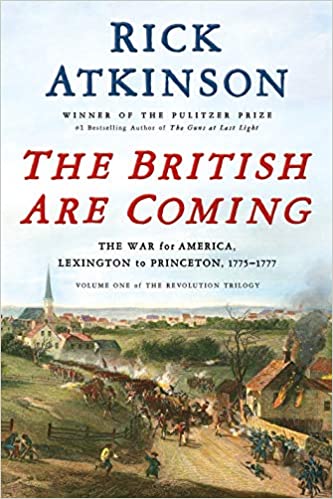Authors:
Historic Era: Era 3: Revolution and the New Nation (1754-1820s)
Historic Theme:
Subject:
Fall 2020 George Washington Prize | Volume 65, Issue 8


Authors:
Historic Era: Era 3: Revolution and the New Nation (1754-1820s)
Historic Theme:
Subject:
Fall 2020 George Washington Prize | Volume 65, Issue 8
Excerpted from the George Washington Book Prize winner The British Are Coming: The War for America, Lexington to Princeton, 1775-1777 (The Revolution Trilogy, 1), by Rick Atkinson (Henry Holt).

For more than 200 years, the House of Commons had met in St. Stephen's Chapel, built within the palace of Westminster in the twelfth century for the monarch's private worship. Window glass depicted biblical stories. Peacock feathers and squirrels' tails had been used to paint angels on the walls and saints around the altar; white down plucked from the breasts of royal swans was daubed in paint to inflect the high blue ceiling with thousands of gold stars.
When Henry VIII shifted to a new palace at Whitehall, old choir stalls became members' benches, a Speaker's chair replaced the altar, whitewash covered the wall paintings, and the spangled ceiling was lowered to improve the acoustics. Architect Christopher Wren added galleries above the debating chamber, which was smaller than a tennis court. The hall retained an ecclesiastical air, even as parliamentarians cracked nuts, peeled oranges, or wandered out through the lobby for a game of whist and a glass of Madeira.
On January 19, when the Commons reconvened after the Christmas holiday, members as usual were packed like sprats in a tin. With a thud, a clerk dropped 149 documents on a central table, announced that they were "papers relating to the disturbances in North America," and in a somber tone began to read the titles of each: Royal Navy dispatches from American waters; seditious extracts from the Continental Congress; reports written by royal officials from New Hampshire to Georgia; official correspondence from London to colonial governors.
Slouched on the Treasury bench to the right of the Speaker's chair, a corpulent, round-shouldered figure listened as the recitation droned on, his eyelids so heavy that he appeared to be dozing. Thick-lipped, with both brow and chin receding, he was said to have a tongue "too large for his mouth" and "prominent eyes that rolled about to no purpose." No matter: Lord Frederick North, a man without vanity who referred to himself as "an old hulk," was always pleased to be underestimated.
In the first decade of George III's reign, six men held the office of prime minister, better known at the time as chief or first minister. They had little in common other than slender competency and an unsteady handling of Parliament. In 1770 the king turned to a childhood playmate--he and North had acted together in a schoolboy production of Joseph Addison's Cato--and a political partnership began that would endure through a dozen difficult years. George knew he had his man when he wrote North just a few months into his new chief minister's tenure, pleading for £13,000 in cash